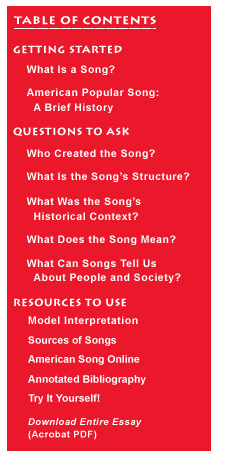talking history | syllabi | students | teachers | puzzle | about us

|
 |
| This seems like the most important question of all, but it is the one that has the most possible answers and where it is hardest to say that any single answer is right. It seems sensible to begin with the obvious: what do the words mean? The problem is that the literal meaning of song lyrics is often hard to establish, and this meaning is usually enriched with allusion, suggestion, and implied meanings. Moreover, the words are only the beginning. How a song is performed contributes a great deal to its meaning. A song performed at a dance tempo means something different from the same song performed as a ballad. Willie Nelson’s performance with a Texas twang, an amplified guitar, and a lonesome harmonica, gives the “blue” in Irving Berlin’s “Blue Skies” (1927) an entirely different meaning from earlier renditions of the song. “Old Folks at Home” (1851) in its original rendition performed by white men in blackface meant something different from “Old Folks” performed by a barbershop quartet, and different again from “Old Folks” performed by an African-American singer like Ray Charles. Contexts are important to meaning, and meanings change over time as contexts change. One of the best ways to get an idea of the different things that a song means and has meant is to see what people have said about it. Responses to songs and interpretations of songs are available not just in reviews but also in poems, novels, and letters. The opinions of the original songwriter are sometimes available, and they should be given special weight. But they should not be taken as a gold standard of meaning, because performers and audiences add many meanings of their own that are also important to a song’s history. The ways in which songs take on different meanings in different settings or eras provide potentially rich examples for understanding popular songs as historical evidence. On the other hand, it is not true that any meaning is as good as any other. Interpretations that contradict the literal meaning of the lyrics or the obvious intent of the performer, that are clearly anachronistic, or that do not correspond to anyone’s actual reaction to the song have to be considered in a different light from meanings that were intended by the creators or that can be shown to be widely shared among audiences. A related question addresses quality–is the song any good? Some American songs have been immensely popular. Most have not. A small number have stayed in the repertory as classics–songs that people know, sing, and love many years after their creation. People often suppose that the songs that become hits, and especially songs that become classics, are better in some way than songs that sink without a trace. People who talk about songs, people who perform songs, people who buy songs all seem to have clear ideas about which songs are good and which songs are bad. But they seldom articulate their aesthetic criteria. Is it possible to propose criteria that can explain why hits are hits and flops are flops? Probably not, since if one could explain a hit in retrospect, then one could also predict a hit, something that has always proved notoriously difficult. On the other hand it should be possible to find out what aesthetic criteria people used to decide whether they loved a song or hated it. And it should also be possible to trace changes in these aesthetic values over time. Among the helpful sources for doing this are musical reviews, personal accounts, letters to performers, and fan magazines.
|
|

|
|

